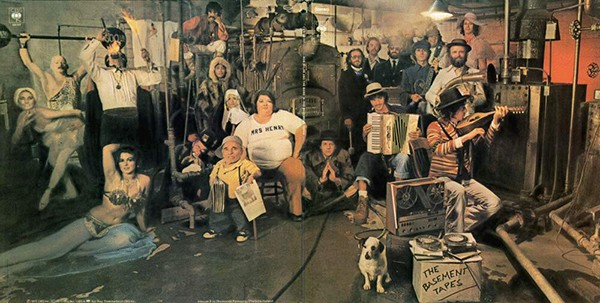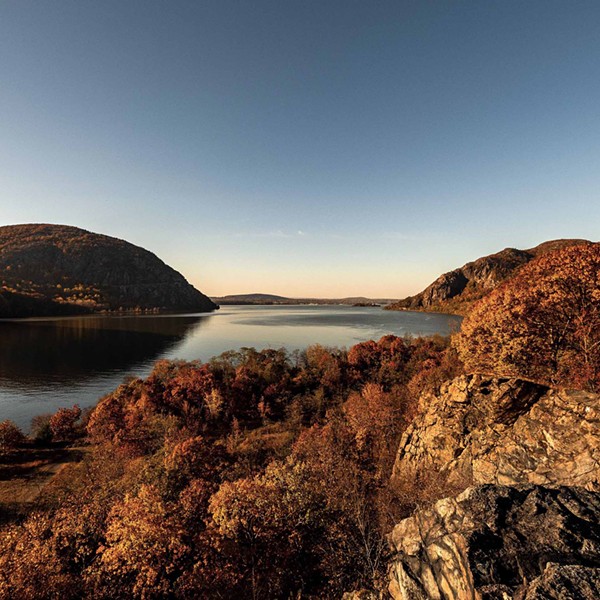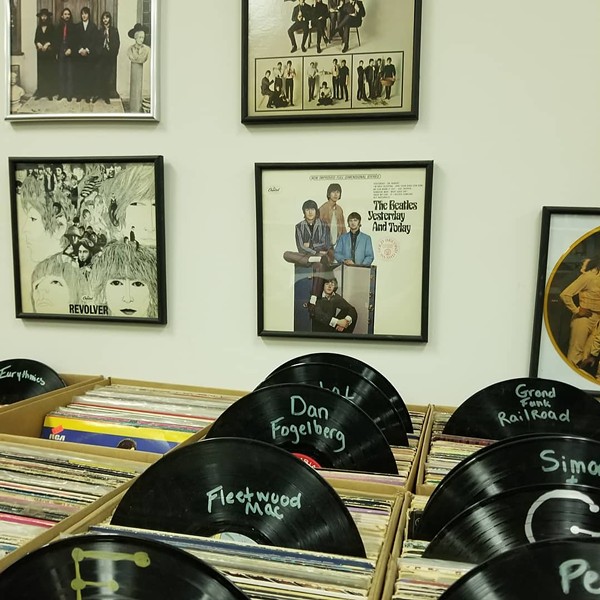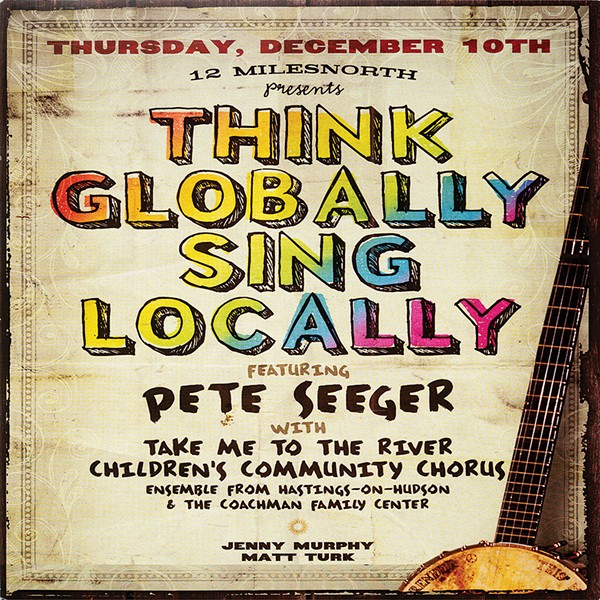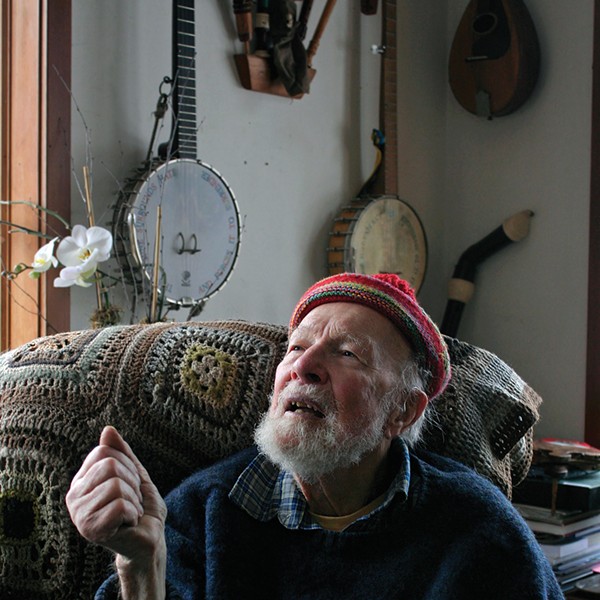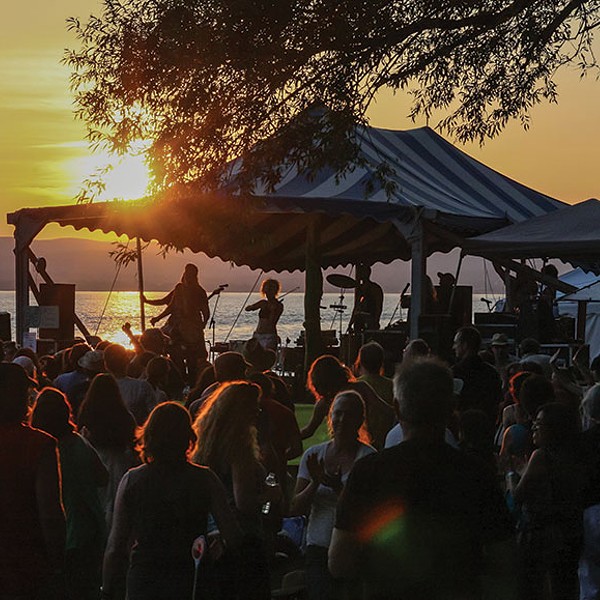From collaborations between some of the world's biggest rock stars to breakthrough albums from up-and-coming artists, a distinctive, widely varied set of albums have been recorded in the Hudson Valley. In honor of Record Store Day, the internationally recognized celebration of independent music stores, we've compiled a list of our top ten most important albums (and one historical musical premiere*) recorded in the Hudson Valley, young and old:
1. The Basement Tapes—Dylan and The Band
Woodstock, various locations (probably some basements)
While the rest of rock and roll was looking forward in 1967, Bob Dylan and The Band were mining the well of strangeness that Greil Marcus terms "old, weird America." Dylan had just crashed his motorcycle, and the backing band from his last tour, the Hawks, consisting of four Canadians (Robbie Robertson, Richard Manuel, Rick Danko, and Garth Hudson), and one Arkansas shitkicker (Levon Helm), gathered around in Woodstock as he convalesced. Just as Dylan turned his back on twee coffeehouse folk music when he plugged in at Newport Folk Fest in 1965, the hundred or so songs that Dylan and the Band recorded in what came to be known as The Basement Tapes (not officially released until 1975) were another turn for Dylan, this time toward an intimate, rootsy sound that prefigured the Americana genre.
But it's the strangeness that gets you. The evocation of Appalachian melancholic oddity as in the traditional "Coo-Coo Bird": "I'd rather be in some dark holler / where the sun refused to shine." God and Satan and Puritans and drunkards and grave robbers and tricksters and nonsense lyrics and Judgment Day all rolled into one. What a strange and beautiful mess it is, this America, it seems to say.
2. Cosmic Thing—B-52s
Dreamland Recording Studios, West Hurley
The B-52s formed in 1978 after sharing a tropical Flaming Volcano drink at a Chinese restaurant. Such a genesis is indicative of the style they'd come to be defined by: surf-rock-inspired party music that celebrates spontaneity and the wild impulses of the young and in love. Taking the New Wave movement of their generation and sun bleaching it, they set the trend for the laid back thrift-store style of the lost-in-time American surf culture. Their fifth studio album, Cosmic Thing, represents a darker side to their signature good-vibes, as it's their comeback album after the death of guitarist and original member Ricky Wilson in 1985. Overcoming doubts about the band's future, 1989's Cosmic Thing introduced the iconic track "Love Shack" to the world, and brought the B-52's back into the mainstream after a period of stagnation—a testament to their carefree ethos despite a devastating loss.
3. Grace—Jeff Buckley
Bearsville Studios, Woodstock
Jeff Buckley recorded what would be his only studio album in the Hudson Valley. Grace, which showcases Buckley's vocal range and stylistic variation on guitar, was initially met with poor reception, but now commonly ranks as one of the best albums of all time. This could be in part because of the young artist's untimely death—in the midst of recording what would be his second album—or his hauntingly somber cover of Leonard Cohen's "Hallelujah," which still stands as the best-known version of the song (despite the legendary original songwriter, or reproductions by such powerhouses as John Cale and Rufus Wainwright), achieving a nearly ubiquitous presence on the soundtracks of modern teenage television soap-dramas. In any case, Grace remains one of the most significant albums of the 20th century, haunted by the abrupt cutting-off of the young artist's potential.
4. Deserter's Songs—Mercury Rev
NRS Recording Studio, Catskill
In some ways, the Kingston-based Mercury Rev can be thought of as spiritual heirs to The Band (a point made by many critics). This was never more apparent than on the band's fourth album, released in 1998. The songs were conceived by recent transplants to the Catskill Mountains by Jonathan Donahue and guitarist Sean "Grasshopper" Mackiowiack, and some make explicit reference to the region, like "Opus 40" (with Levon Helm sitting in on drums) and "Hudson Line" (Garth Hudson on sax). But the true lineage is again to that lost map of America that The Band set off to find in their music. Mercury Rev went about differently, sure, with chamber pop pretension and Donahue's airy art rock vocals that were a far cry from The Band's often growling shambolic mess. But the stab at transcendence through calculated strangeness—the grab at the unspoken myth that lurks at the heart of this country—was the same. Deserter's Songs is all the proof you need that we do weird well in the Hudson Valley.
5. Green—R.E.M
Bearsville Studios, Woodstock
Though the '90s alternative rock group's earlier guitar-driven albums are masterpieces in their own right, there's something about R.E.M's acoustic songs that drive right to your core, with Michael Stipe's full and softly wavering voice front and center, like a pot of water just starting to boil. Green represents a departure from their traditional folk-rock style and a movement into the acoustic approach that would influence their two subsequent albums. Partially recorded near the idyllic natural setting of Woodstock, Green also marks a development in the band's political engagements, conceptually influenced by environmentalism and green politics. The album's division into two thematically distinct parts—the "Air side" and the "Metal side"—points to an experimentation with style that the band first started exploring in Green.
6. Tigerlily—Natalie Merchant
Bearsville Studios, Woodstock
Merchant's first solo album after splitting from the 10,000 Maniacs, which catapulted her into the Lilith Fair fem-alt-rock scene. While on death row, serial killer Aileen Wuornos spent many hours listening to the album, and requested that the song "Carnival" be played at her funeral.
7. Z—My Morning Jacket
Allaire Studios, Shokan
This album marks a major shift in MMJ's sound, moving from a reverb-saturated psychedelic style to a more polished and focused product with a synth-driven, otherworldly quality. When Pitchfork listed Z as one of the top 200 albums of the 2000s, they called it My Morning Jacket's OK Computer.
8. The Monitor—Titus Andronicus
Marcata Recording, Gardiner
With their second studio album, The Monitor, Titus Andronicus achieved a seemingly impossible feat in the ephemeral age of the mp3: They created a timeless album. In one fell swoop, The Monitor encapsulates varied iterations of the American dream, meshing the rhetoric of the Civil War with Bruce Springsteen's blue-collar Americana with the breathless urgency of the post-rock era. "The Gettysburg Address" goes punk.
9. Heathen—David Bowie
Allaire Studios, Shokan
The long-time Hudson Valley resident and English rock-monolith's 22nd studio album, the recording of which started before and finished after the events of September 11, 2001. Themes of angst, disillusion, and fear are explored in songs that many believe to have been influenced by the attacks, including "Slow Burn", "Afraid", and "A Better Future".
10. Under the Table—Dave Matthews Band
Bearsville Studios, Woodstock
DMB's first studio album, which brought national recognition to the jam-rock band that would come to be one of the most popular of all time, effortlessly selling out the world's largest arenas for their annual summer tours. Under the Table was dedicated to Matthews's sister, Anne, who was killed by her husband in 1994.
*4'33"—John Cage
Premiered at the Maverick Concert Hall, Woodstock, 1952
The experimental composer's legendary three-part composition, which consists of four minutes and 33 seconds of silence, was meant to make listeners more aware of the musicality of their environment. Cage's most famous and controversial work is founded in his idea that, "Everything we do is music".
Runners Up
Come Away with Me—Norah Jones
Teen Dream—Beach House
Billy Breathes—Phish







